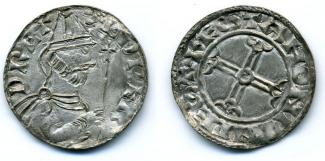Silver penny of Edward the Confessor
Anglo-Saxon, 1053-1056
Found during archaeological excavations on the Cathedral Green, Winchester, Hampshire
Following the death of Harthacnut in 1042 Edward the Confessor became king remaining on the throne until his death in 1066. Edward's sympathies lay with the home and friends of his youth - Normandy. He spoke their language, introduced their habits and laid the foundations for the great events of 1066. His coinage, however, is a continuation of what went before. This coin is the most common type of his reign. The obverse has a bust of Edward, bearded, wearing a pointed helmet and holding a sceptre in his right hand. The moneyer was Aestan, the reverse inscription reading +AESTAN ON PINCEST ('Aestan of Winchester'). The 'P' represents the Anglo-Saxon 'wen' character pronounced 'w'.



